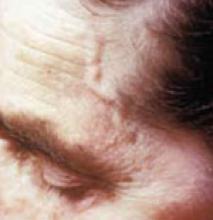Jaw claudication, diplopia, or a temporal artery abnormality on physical exam increase the likelihood of temporal arteritis. A finding of thrombocytosis in a patient with suspected temporal arteritis moderately increases the likelihood of this diagnosis (strength of recommendation: B, based on systematic reviews of retrospective cohort studies).
Patients with temporal arteritis frequently complain of headaches, and often have mildly abnormal erythrocyte sedimentation rates (ESR), but neither of these findings helps in the diagnosis.
You may forgo biopsy if clinical probability is sufficiently high
Derek Wright, MD
Idaho state university Family Medicine, Pocatello
Because treatment for temporal arteritis involves at least several months of glucocorticoids, most clinicians prefer to confirm the diagnosis with a temporal artery biopsy. However, a unilateral biopsy has a sensitivity of only 86%; thus, a negative biopsy does not always exclude the diagnosis. As a result, many patients will be treated for temporal arteritis even after a negative biopsy because of a high clinical suspicion of the diagnosis.
It is therefore reasonable to forgo biopsy if the clinical probability of temporal arteritis is sufficiently high that one would treat for the disease even if the biopsy result were negative. Given the variable and often nonspecific nature of symptoms and findings, it is helpful to know which clinical features increase the likelihood of the disease.
Evidence summary
The prevalence of temporal arteritis (also called giant cell arteritis) increases significantly with age. For those under 50 years of age, this condition is extremely rare; the prevalence increases exponentially with age.1
Jaw claudication quadruples likelihood of temporal arteritis
A 2002 systematic review2 and a 2005 decision analysis3 examined validating cohort studies to determine the likelihood ratios of symptoms, signs, and blood tests (TABLE). These cohort studies are subject to verification bias, as most cohorts represent a selected sample of patients who had a positive temporal artery biopsy. The authors of the 2005 decision analysis note that unilateral temporal artery biopsy has a mean sensitivity of 86.9% (95% confidence interval [CI], 83.1%–90.6%) when compared with a gold standard derived from bilateral artery biopsy, American College of Rheumatology criteria, or clinical diagnosis.3
A headache—even a temporal headache—has a low positive likelihood ratio. Diplopia doubles and jaw claudication quadruples the likelihood of temporal arteritis, but the presence of other symptoms (such as anorexia, weight loss, arthralgia, fatigue, fever, polymyalgia rheumatica, vertigo, and unilateral visual loss) does not significantly increase the probability of temporal arteritis. An abnormal temporal artery on physical examination doubles the likelihood of temporal arteritis.2
TABLE
Jaw claudication and thrombocytosis increase likelihood of temporal arteritis2,3
| SYMPTOMS AND SIGNS | LR+ (95% CI) | LR– (95% CI) | SENSITIVITY (95% CI) |
|---|---|---|---|
| Diplopia | 2.0 (1.3–3.1) | 1.0 (0.9–1.0) | 0.09 (0.07–0.13) |
| Headache | 1.2 (1.0–1.4) | 0.7 (0.6–1.0) | 0.76 (0.72–0.79) |
| Headache, temporal | 1.5 (0.8–3.0) | 0.8 (0.6–1.0) | 0.52 (0.36–0.67) |
| Jaw claudication | 4.0 (2.4–6.8) | 0.8 (0.7–0.9) | 0.34 (0.29–0.41) |
| Temporal artery abnormality, any | 2.0 (1.4–3.0) | 0.5 (0.4–0.8) | 0.65 (0.54–0.74) |
| TESTS | |||
| ESR <50 | 0.6 (0.2–1.3) | 1.6 (0.8–3.3) | Not available |
| ESR 50–100 | 1.1 (0.6–2.0) | 1.0 (0.6–1.6) | Not available |
| ESR >100 | 2.5 (0.7–8.3) | 0.8 (0.5–1.1) | 0.39 (0.29–0.50) |
| Platelets >375,000 | 6.0 (1.4–24) | 0.6 (0.4–0.9) | Not available |
| LR, likelihood ratio; ESR, erythrocyte sedimentation rate; CI, confidence interval. | |||


